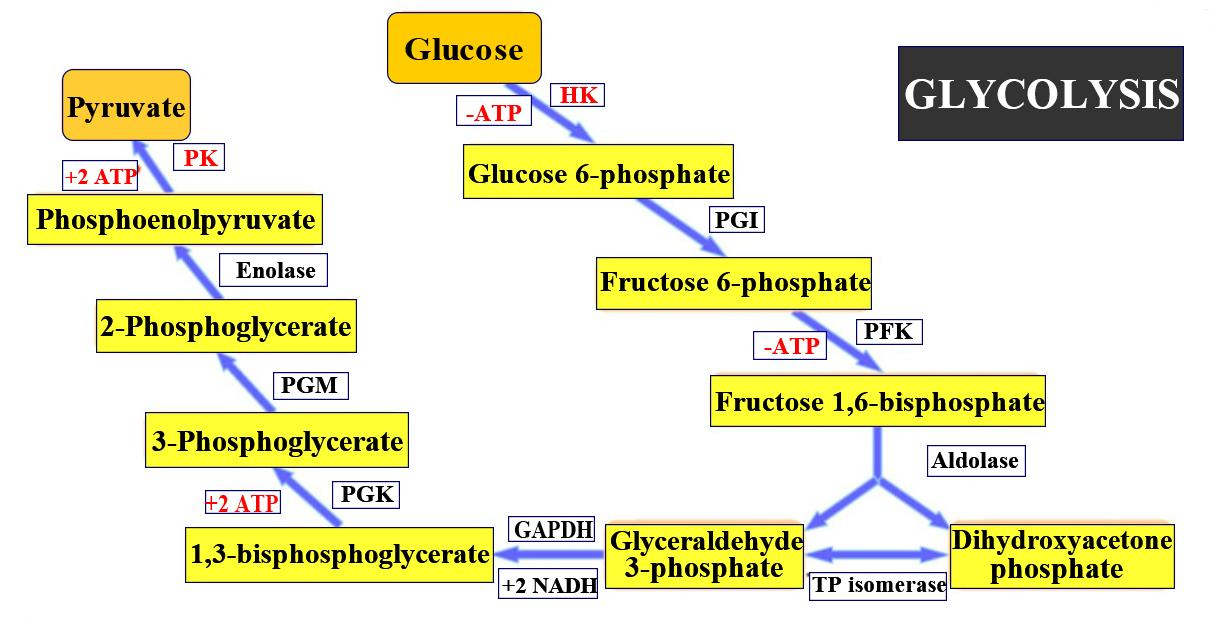
High energy compounds
(a) Are compounds that release a large amount of energy during respiration.
(b) Are produced when ATP loses two terminal phosphate groups.
(c) Are produced in respiration only
(d) Are referred to as those compounds which link exergonic and endergonic reactions.
Answer
463.8k+ views
Hint: High energy compounds yield energy by hydrolysis, it consists of Acid anhydride bond which forms by condensation of the acidic group when these bonds break it releases free energy.
Complete Answer:
A high energy compound is ATP which releases a high amount of energy during respiration and metabolism. Blackman suggested two types of respiration one in which fats and carbohydrates are oxidized and the second in which protein acts as a respiratory substrate. This type of respiration takes place during starvation.

Cellular respiration depends on the presence and absence of oxygen where the formation of ATP takes place.
Additional information: In cellular respiration, the release of energy takes place during the process of glycolysis. Glycolysis takes place in the cytoplasm where one glucose molecule breaks to form two pyruvate molecules, it takes place in both aerobic and anaerobic types of respiration. Glycolysis was discovered by Gustav Embden, Otto Meyerhof, and J. Parnas, therefore, it is also called an EMP pathway. Glycolysis is a ten-step process in which the first half activates glucose, this phase is the preparatory phase and the second half involves the extraction of energy which is the payoff phase. In glycolysis one molecule of hexose splits to form two molecules of 3 carbon compound pyruvic acid, four ATP molecules are produced and 2 ATP are consumed with a net gain of 2ATP molecules. In the case of aerobic respiration 6 extra ATP are produced during transportation of NADH from the cytoplasm to mitochondria therefore net 8 ATP are produced. Aerobic glycolysis is more efficient than anaerobic glycolysis.
So, the correct answer is ‘(a) Are compounds that release a large amount of energy during respiration’.
Note: In glycolysis three steps are irreversible and step number five is non-enzymatic where conversion of phosphoglyceraldehyde into 1,3-phosphoglyceraldehyde takes place. Irreversible steps take place by hexokinase, phosphofructokinase, and pyruvate kinase, these enzymes show catalytic roles and control the process of glycolysis.
Complete Answer:
A high energy compound is ATP which releases a high amount of energy during respiration and metabolism. Blackman suggested two types of respiration one in which fats and carbohydrates are oxidized and the second in which protein acts as a respiratory substrate. This type of respiration takes place during starvation.

Cellular respiration depends on the presence and absence of oxygen where the formation of ATP takes place.
Additional information: In cellular respiration, the release of energy takes place during the process of glycolysis. Glycolysis takes place in the cytoplasm where one glucose molecule breaks to form two pyruvate molecules, it takes place in both aerobic and anaerobic types of respiration. Glycolysis was discovered by Gustav Embden, Otto Meyerhof, and J. Parnas, therefore, it is also called an EMP pathway. Glycolysis is a ten-step process in which the first half activates glucose, this phase is the preparatory phase and the second half involves the extraction of energy which is the payoff phase. In glycolysis one molecule of hexose splits to form two molecules of 3 carbon compound pyruvic acid, four ATP molecules are produced and 2 ATP are consumed with a net gain of 2ATP molecules. In the case of aerobic respiration 6 extra ATP are produced during transportation of NADH from the cytoplasm to mitochondria therefore net 8 ATP are produced. Aerobic glycolysis is more efficient than anaerobic glycolysis.
So, the correct answer is ‘(a) Are compounds that release a large amount of energy during respiration’.
Note: In glycolysis three steps are irreversible and step number five is non-enzymatic where conversion of phosphoglyceraldehyde into 1,3-phosphoglyceraldehyde takes place. Irreversible steps take place by hexokinase, phosphofructokinase, and pyruvate kinase, these enzymes show catalytic roles and control the process of glycolysis.
Recently Updated Pages
The correct geometry and hybridization for XeF4 are class 11 chemistry CBSE

Water softening by Clarks process uses ACalcium bicarbonate class 11 chemistry CBSE

With reference to graphite and diamond which of the class 11 chemistry CBSE

A certain household has consumed 250 units of energy class 11 physics CBSE

The lightest metal known is A beryllium B lithium C class 11 chemistry CBSE

What is the formula mass of the iodine molecule class 11 chemistry CBSE

Trending doubts
Why was the Vernacular Press Act passed by British class 11 social science CBSE

Arrange Water ethanol and phenol in increasing order class 11 chemistry CBSE

Name the nuclear plant located in Uttar Pradesh class 11 social science CBSE

One Metric ton is equal to kg A 10000 B 1000 C 100 class 11 physics CBSE

What steps did the French revolutionaries take to create class 11 social science CBSE

How did silk routes link the world Explain with three class 11 social science CBSE




